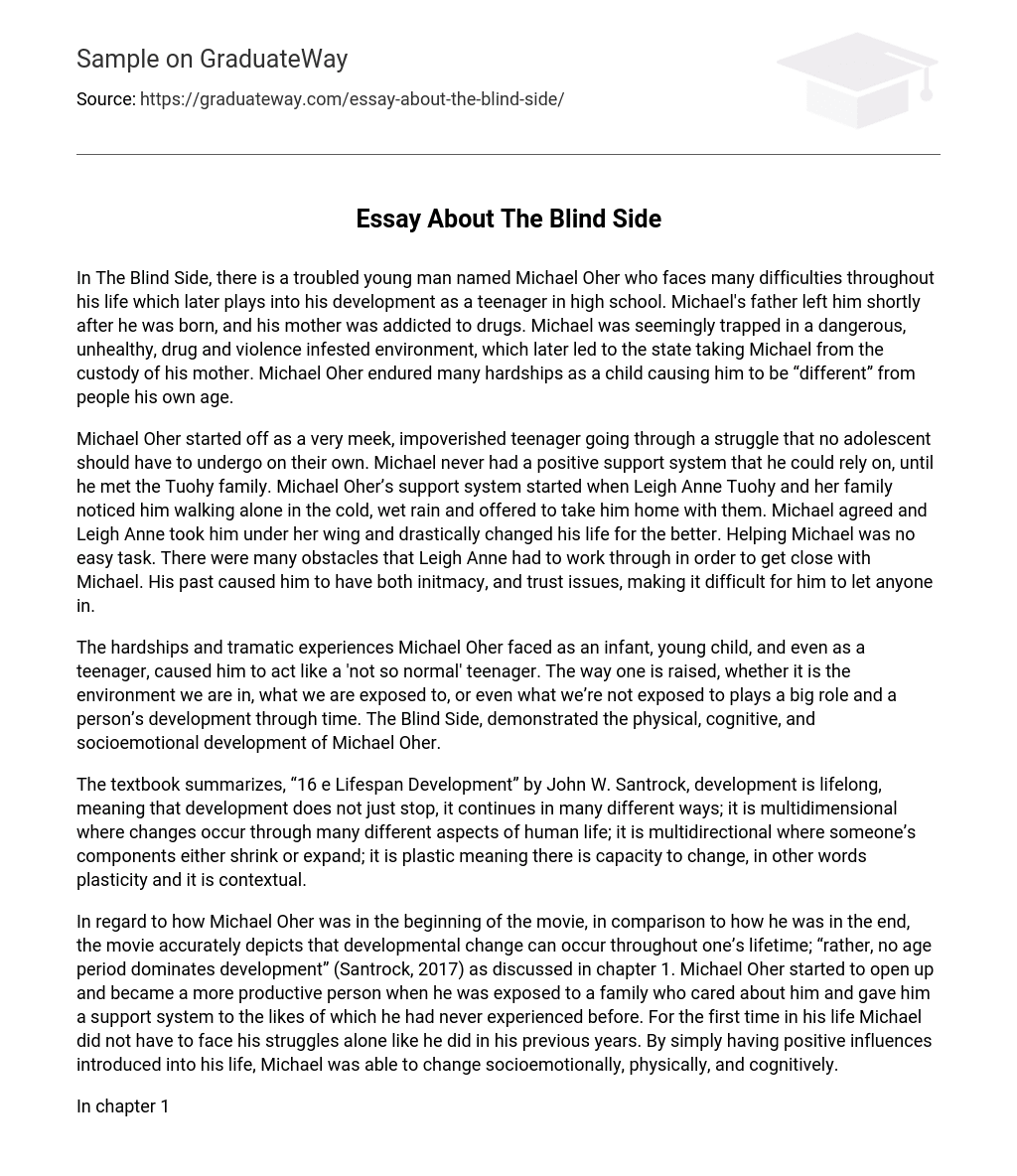In The Blind Side, there is a troubled young man named Michael Oher who faces many difficulties throughout his life which later plays into his development as a teenager in high school. Michael’s father left him shortly after he was born, and his mother was addicted to drugs. Michael was seemingly trapped in a dangerous, unhealthy, drug and violence infested environment, which later led to the state taking Michael from the custody of his mother. Michael Oher endured many hardships as a child causing him to be “different” from people his own age.
Michael Oher started off as a very meek, impoverished teenager going through a struggle that no adolescent should have to undergo on their own. Michael never had a positive support system that he could rely on, until he met the Tuohy family. Michael Oher’s support system started when Leigh Anne Tuohy and her family noticed him walking alone in the cold, wet rain and offered to take him home with them. Michael agreed and Leigh Anne took him under her wing and drastically changed his life for the better. Helping Michael was no easy task. There were many obstacles that Leigh Anne had to work through in order to get close with Michael. His past caused him to have both initmacy, and trust issues, making it difficult for him to let anyone in.
The hardships and tramatic experiences Michael Oher faced as an infant, young child, and even as a teenager, caused him to act like a ‘not so normal’ teenager. The way one is raised, whether it is the environment we are in, what we are exposed to, or even what we’re not exposed to plays a big role and a person’s development through time. The Blind Side, demonstrated the physical, cognitive, and socioemotional development of Michael Oher.
The textbook summarizes, “16 e Lifespan Development” by John W. Santrock, development is lifelong, meaning that development does not just stop, it continues in many different ways; it is multidimensional where changes occur through many different aspects of human life; it is multidirectional where someone’s components either shrink or expand; it is plastic meaning there is capacity to change, in other words plasticity and it is contextual.
In regard to how Michael Oher was in the beginning of the movie, in comparison to how he was in the end, the movie accurately depicts that developmental change can occur throughout one’s lifetime; “rather, no age period dominates development” (Santrock, 2017) as discussed in chapter 1. Michael Oher started to open up and became a more productive person when he was exposed to a family who cared about him and gave him a support system to the likes of which he had never experienced before. For the first time in his life Michael did not have to face his struggles alone like he did in his previous years. By simply having positive influences introduced into his life, Michael was able to change socioemotionally, physically, and cognitively.
In chapter 1, page 21, discusses Erickson’s theory of development. The first stage is the trust versus mistrust. This is where an infant develops their trust in the world, an expectation that the world will either be good or bad. Michael Oher was not in a good place when he was a child, he was neglected by his mother and abandoned by his father. This is where he developed trust issues. While he was in the foster care system he was known as ‘the runner’ because he would typically flee from his caregivers. As a child he couldn’t even have certainty of his own mother, causing him to have issues trusting anyone trying to care for him.
From Michael being a runaway, we can make the assumption that school was not his strong-suit. Therefor he did not direct much of his energy into scholarly intellect. Instead he developed “street smarts,” since he had to take care of himself for a large amount of time. Erickson’s third stage of development, industry versus inferiority is what caused Michael to doubt himself when he first started attending the private Christian school. He really had not invested much focus on his academic progress when he was younger, so he did not posses the mental skills needed to progress at the time. And the last of Erickson’s developmental theory that the movie portrays is the identity versus identity issue.
The Touhy family directed Michael into a positive path in helping him pursue trust, as well as confidence within himself. Without Michael pursuing these self-qualities he would have obtained a lot of identity issues. In chapter 1, page 7, the textbook talks about nonnormative life events which are “unusual occurrences that have a major impact on the lives of individual people. These events do not happen to everyone, and when they do occur they can influence people in different ways” (Santrock, 2017). And the nonnormative events that Michael had to endure, shaped him in the person he was before the Touhy family.





